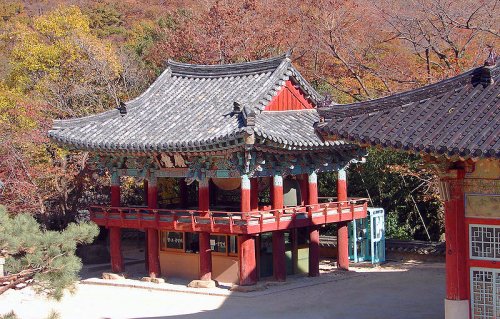 Busan, South Korea
Busan, South KoreaSource: https://commons.wikimedia.org/wiki/File:Busan_Skyline.JPG
Author: ASDFGH

Author: ASDFGH

[an error occurred while processing this directive]
Busan (부산), formerly written as Pusan, is the second biggest city in South Korea. The population is now at around 3.5 million. It is the largest port city for South Korea, and the fifth largest in the world.
Busan is located at the southeasternmost tip of the Korean peninsula facing the Korean Strait. It played host to the 2002 Asian Games and the APEC 2005 Korea.
The history of Busan goes back to at least AD 300, with evidence of burial mounds of a chiefdom that existed during that time. The Busan district of Dongnae has been documented as early as the 8th century.
Busan was opened to trade and settlement with Japan in the 15th century, culminating with the Japanese invasion of Korea between 1592 and 1598, also called the Seven Year War. The Busan settlement suffered greatly from the war. Nevertheless the Japanese developed Busan into a trading hub. It was the only city to introduce a steam tramway before electrification was in place, and the only two major cities in South Korea not to be captured by the North Korean troops during the first three months of the Korean War.
Today Busan has grown into a world-class metropolis. Its robust economy has translated into several engineering projects, including the construction of the 110-storey 510-meter Lotte Super Tower, slated for completion in 2013, to assume a position as the third tallest skyscraper in the world, behind Burj Khalifa and 1 World Trade Center.
Going to Busan
By PlaneBusan's Gimhae International Airport (PUS) receives domestic as well as international flights. Due to the airport doubling as an air force base, photography is not allowed of the airport inside or outside the plane.
For budget travelers, the most economical option is to take the public buses between the airport and downtown Busan. The fare is only ₩1,000. Alternatively you can take the airport limousine buses for ₩6,000. The most expensive option is of course the taxi, which will set you back around ₩15,000 inclusive of toll.
By Train from Seoul
The KTX High-Speed Train by Korea Railroad connects Seoul to Busan in a blazing 175 minutes for ₩51,700.
Travel within Busan
Riding the subwayThree subway lines drap around Busan like casually tossed strands of pearls. They are color coded as follows: Orange (Line 1), Green (Line 2) and Brown (Line 3).
Line 1, which forms the backbone of the system, goes north-south through Busan from Nopo-dong station to Sinpyeong station.
Line 2 makes a "U" from Hopo station (with extension under construction to Bukjeong) in the northwest to Jangsan station in the northeast. It intersects Line 1 at Seomyeon station.
Line 3 cuts across Busan from Daejeo station in the west to Suyeong station in the east. It intersects with Line 1 at Yeonsan-dong station. It also intersects with Line 2 at Deokcheong station to the west, and terminates at Yeonsan-dong station, also served by Line 2.
Line 4 is under construction. It links Minam station, where it will intersect with Line 3, eastwards to Anpyeong.
Fare on the subway is ₩1,100 for travel of distances less than 10 km and ₩1,300 for distances exceeding that. The vending machines accept only either banknotes or coins. If you plan to use the subway extensively, get either the one-day pass for unlimited rides, for ₩3,500 or the stored-value cards Hanaro Card or Digital Busan Card, which gives a 10% discount on rides.
Taking the taxi
The flag drop rate is ₩2,200 for the first 2 km, and then it's ₩100 for every 143 meters, or every 34 seconds if the taxi is moving at less than 15 kph. A surcharge of 20% is added for rides between midnight and 4:00 am.
Photos of Busan
 Bell Tower of Beomeosa Temple, Busan
Bell Tower of Beomeosa Temple, BusanSource: https://commons.wikimedia.org/wiki/File:Korea-Busan-Beomeosa_6250-07_Bell_Pavilion.JPG
Author: Steve46814

Author: Steve46814

Places of Interest in Busan
- Yongdusan Park
Park in Busan with gorgeous views of Busan skyline. - Jagalchi Fish Market
Marketplace at Busan Waterfront, good place to view the fish vendors and their oceanic fare. - Texas Street
Also called Russian Street, a shopping street with clothing and accessory stores. - Dongnae Fortress
Medieval fortress built to repel Japanese invasion of the 16th century. - Chungyeol-sa Shrine
Shrine commemorating the soldiers who died fighting the Japanese in the 16th century invasion. - Dongnae Hot Spring
Hot Spring resort in Busan. - Geumjeongsanseong
Mountain fortress built in the Joseon Dynasty. - Geumgang Park
Park with cable car ride. - Beomeo-sa Temple
The most important temple in Busan. - Songdo Beach
Beach to the southwest of downtown Busan. - Haeundae
Beach resort in Busan. - Taejongdae Park
Picturesque park on the southern tip of Yeong-do Island. - Masan
An industrial city and port in Busan. - Jinhae
Naval station but famous for its cherry blossoms.
 Latest updates on Penang Travel Tips
Latest updates on Penang Travel Tips
 Map of Roads in Penang
Map of Roads in Penang
Looking for information on Penang? Use this Map of Roads in Penang to zoom in on information about Penang, brought to you road by road.
Copyright © 2003-2025 Timothy Tye. All Rights Reserved.

 Go Back
Go Back